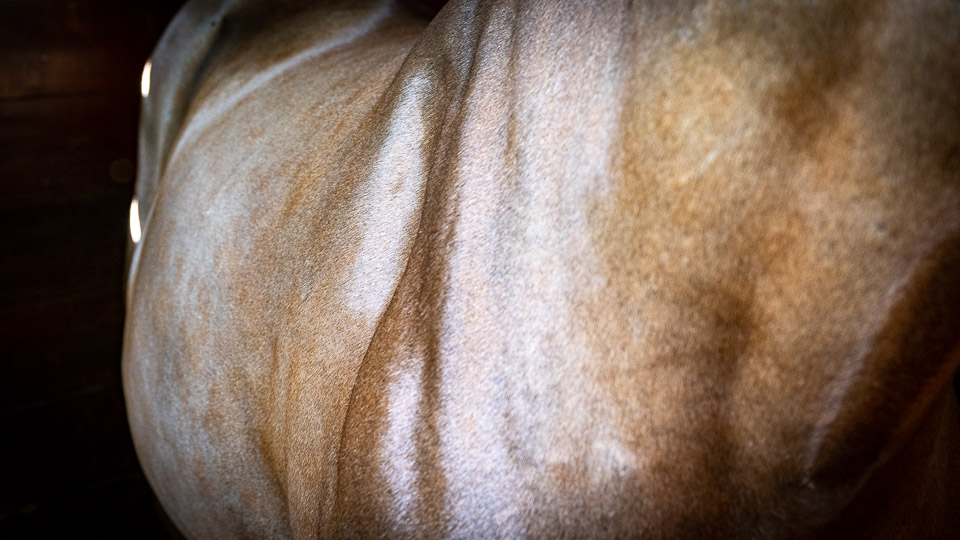
Horse Nervous System – An Introduction
The nervous system is complicated because it is in charge of so many things. Basically there are 3 sections and 2 operating systems. There is the brain stem which houses the ancient portion that connects the brain to the body through the cranial and spinal nerves. Here the basics are covered such as breathing and digestion movements. On top of this is ancient center is the cortex which has a more developed portion of the brain and does some of the thinking. Here is where we feel hunger, danger and the need to reproduce. Over this is a very thin layer called the neocortex which houses all of the memories of our life. All 3 sections connect with an uncountable number of nerve fibers interacting using chemicals called neurotransmitters. The 2 operating systems are the parasympathetic and the sympathetic which control the non-thinking parts (heart beat, digestive contractions, etc) or the voluntary parts (I’m hungry and I’m going eat).
Through shared connections, all sections of the brain use patterns to cause actions. Hunger may come from either the action of a hormone secreted by various factors such as an empty stomach or from a smell (fresh muffins from the oven) or from a visual (see a commercial on TV or see the barn worker arrive = feeding time). Seeing some foods may cause us not to eat it because last time it was eaten there was a violent stomach reaction (memory of a bad event).
There are groups of cells identified in the brain of all animals that are called islands and are named. Of importance to horses are the amygdala which stores emotions including the fight or flight survival reaction. Directly connected to this is the motor cortex where movement starts. This connection is responsible for the explosive reaction a horse may have to a stimulus such as a surprise movement outside the window. Only in a long moment does the horse understand the movement and no longer moves as his safety is assured, but you might be injured from his reaction. Other times they connect a person (trainer, vet) with an unwelcome emotion in the amygdala and running or rearing occurs. What needs to be changed then is the stimulus and the reaction to that stimulus (training).
The number of problems in the nervous system of horses are limited to central (brain) and peripheral (nerves). Central diseases include rabies and other viral infections, meningitis from a bacterial infection and dummy foal syndrome from lack of oxygen at birth. Also cataplexy / narcolepsy where the horse suddenly collapses apparently asleep and Cushing’s disease and other neurodegenerative syndromes where the hypothalamus of the brain no longer communicates with the pituitary.
Peripheral nerve diseases (neuropathies) include direct trauma to any nerve (Sweeney and other muscle atrophies due to nerve loss), secondary trauma (wobblers, roaring) and inflammatory diseases (head shakers, shivers).
New discoveries in the human brain could also be thought to occur in horses. It is known that there is a unique lymph system of the brain called the glymph system. This fluid bathes the brain after it shrinks up to 40% during deep sleep (delta wave) cleansing the brain of waste. Cognitive dysfunction in humans has been associated with inflammation due to diet and dementia in humans is now being called diabetes type 3. Something similar in horses is not known but could this be happening to horses with metabolic syndrome and insulin resistance (diabetes)? No one is testing for this in horses.
New nerve diseases in horses since I went to vet school include ALS (Lou Gehrig’s Disease) and head shaker syndrome. Other nerve diseases that have increased are cataplexy and shivers. I’ll look at all of these in the included topics.
Horse Nervous System – Bell’s Palsy (Horner’s Syndrome)
Bell’s Palsey or Horner’s Syndrome is a paralysis of one side of the face usually caused in horses by trauma.
Horse Nervous System – Cataplexy / Narcolepsy / Sleeping Disorder
Cataplexy (Narcolepsy) In Horses
Horse Nervous System – Degenerative Nerve Diseases
Neuroaxonal dystrophy, equine degenerative myelopathy and equine motor neuron disease are discussed here.
Horse Nervous System – Encephalopathy
Encephalopathy In Horses
Horse Nervous System – Head Shaking Syndrome
Head shaking syndrome is when a horse snaps their head in an up and down direction sometimes violently and uncontrollably. Often associated with this is intense and uncontrollable rubbing of their nostrils and face. While the cause is unknown, triggers of HSS include bright light and noise. This is a new disease in horses not seen before 1990.
Horse Nervous System – Neurogenic Atrophy
Neurogenic Atrophy In Horses
Horse Nervous System – Shivers
Shivers In Horses
Horse Nervous System – Unknown Neuropathy
Unknown Neuropathy In Horses
Horse Nervous System – Wobblers In Horses (Cervical Stenotic Myelopathy)
Wobblers In Horses (Cervical Stenotic Myelopathy)
The End Of A Year – Tetanus In A Horse
This is a story about tetanus in a foal, a bacterial disease that paralyzes horses (and humans) killing them when they can no longer breathe. We vaccinate for this disease and it is almost 100% effective – if done correctly.
Horse Parasitic Diseases – EPM In Horses (Equine Protozoal Myelitis)
EPM In Horses (Equine Protozoal Myelitis)
Horse Nervous System – Rabies
Rabies In Horses
Podcast #012 – Fight Or Flight In Horses
Fight Or Flight In Horses– The Horse’s Advocate Podcast #012
Podcast #013 – Sleep In Horses
Sleep In Horses– The Horse’s Advocate Podcast #013
Sleep In Horses
Weather And Horses


Responses